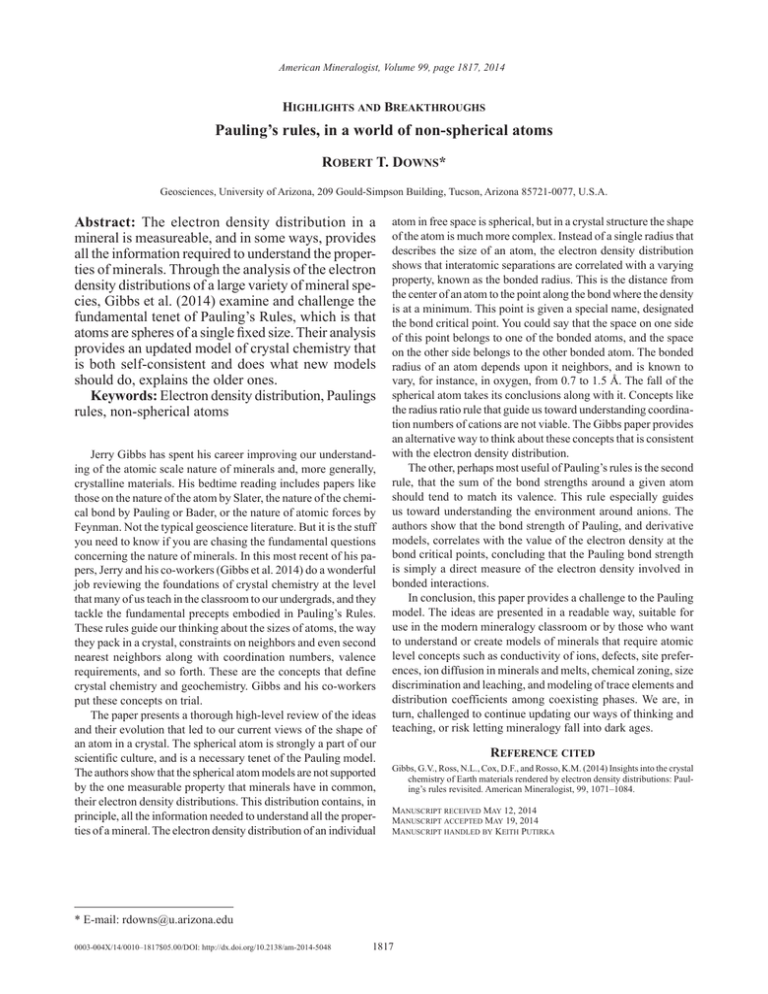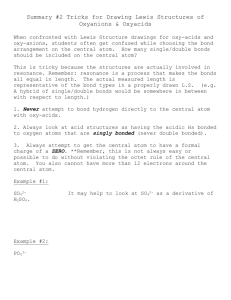Pauling’s rules, in a world of non-spherical atoms r t. d *
advertisement

American Mineralogist, Volume 99, page 1817, 2014 Highlights and Breakthroughs Pauling’s rules, in a world of non-spherical atoms Robert T. Downs* Geosciences, University of Arizona, 209 Gould-Simpson Building, Tucson, Arizona 85721-0077, U.S.A. Abstract: The electron density distribution in a mineral is measureable, and in some ways, provides all the information required to understand the properties of minerals. Through the analysis of the electron density distributions of a large variety of mineral species, Gibbs et al. (2014) examine and challenge the fundamental tenet of Pauling’s Rules, which is that atoms are spheres of a single fixed size. Their analysis provides an updated model of crystal chemistry that is both self-consistent and does what new models should do, explains the older ones. Keywords: Electron density distribution, Paulings rules, non-spherical atoms Jerry Gibbs has spent his career improving our understanding of the atomic scale nature of minerals and, more generally, crystalline materials. His bedtime reading includes papers like those on the nature of the atom by Slater, the nature of the chemical bond by Pauling or Bader, or the nature of atomic forces by Feynman. Not the typical geoscience literature. But it is the stuff you need to know if you are chasing the fundamental questions concerning the nature of minerals. In this most recent of his papers, Jerry and his co-workers (Gibbs et al. 2014) do a wonderful job reviewing the foundations of crystal chemistry at the level that many of us teach in the classroom to our undergrads, and they tackle the fundamental precepts embodied in Pauling’s Rules. These rules guide our thinking about the sizes of atoms, the way they pack in a crystal, constraints on neighbors and even second nearest neighbors along with coordination numbers, valence requirements, and so forth. These are the concepts that define crystal chemistry and geochemistry. Gibbs and his co-workers put these concepts on trial. The paper presents a thorough high-level review of the ideas and their evolution that led to our current views of the shape of an atom in a crystal. The spherical atom is strongly a part of our scientific culture, and is a necessary tenet of the Pauling model. The authors show that the spherical atom models are not supported by the one measurable property that minerals have in common, their electron density distributions. This distribution contains, in principle, all the information needed to understand all the properties of a mineral. The electron density distribution of an individual atom in free space is spherical, but in a crystal structure the shape of the atom is much more complex. Instead of a single radius that describes the size of an atom, the electron density distribution shows that interatomic separations are correlated with a varying property, known as the bonded radius. This is the distance from the center of an atom to the point along the bond where the density is at a minimum. This point is given a special name, designated the bond critical point. You could say that the space on one side of this point belongs to one of the bonded atoms, and the space on the other side belongs to the other bonded atom. The bonded radius of an atom depends upon it neighbors, and is known to vary, for instance, in oxygen, from 0.7 to 1.5 Å. The fall of the spherical atom takes its conclusions along with it. Concepts like the radius ratio rule that guide us toward understanding coordination numbers of cations are not viable. The Gibbs paper provides an alternative way to think about these concepts that is consistent with the electron density distribution. The other, perhaps most useful of Pauling’s rules is the second rule, that the sum of the bond strengths around a given atom should tend to match its valence. This rule especially guides us toward understanding the environment around anions. The authors show that the bond strength of Pauling, and derivative models, correlates with the value of the electron density at the bond critical points, concluding that the Pauling bond strength is simply a direct measure of the electron density involved in bonded interactions. In conclusion, this paper provides a challenge to the Pauling model. The ideas are presented in a readable way, suitable for use in the modern mineralogy classroom or by those who want to understand or create models of minerals that require atomic level concepts such as conductivity of ions, defects, site preferences, ion diffusion in minerals and melts, chemical zoning, size discrimination and leaching, and modeling of trace elements and distribution coefficients among coexisting phases. We are, in turn, challenged to continue updating our ways of thinking and teaching, or risk letting mineralogy fall into dark ages. Reference cited Gibbs, G.V., Ross, N.L., Cox, D.F., and Rosso, K.M. (2014) Insights into the crystal chemistry of Earth materials rendered by electron density distributions: Pauling’s rules revisited. American Mineralogist, 99, 1071–1084. Manuscript received May 12, 2014 Manuscript accepted May 19, 2014 Manuscript handled by Keith Putirka * E-mail: rdowns@u.arizona.edu 0003-004X/14/0010–1817$05.00/DOI: http://dx.doi.org/10.2138/am-2014-5048 1817






